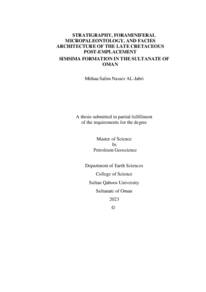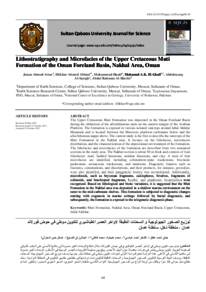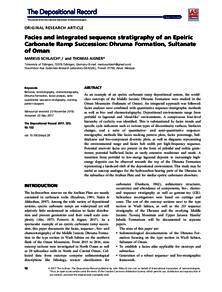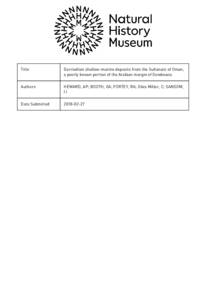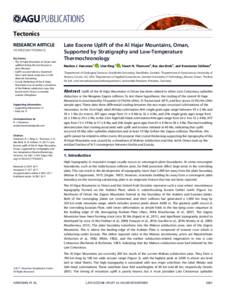Document
Stratigraphy, foraminiferal micropaleontology, and facies architecture of the Late Cretaceous post-emplacement Simsima Formation in the Sultanate of Oman.
Other titles
علم الإستراتيجية، وعلم الأحافير الدقيقة للأشكال الدقيقة للغشاء الكربوني في نهاية العصر الطباشيري للتكوين السمسمة في سلطنة عمان
Publisher
Sultan Qaboos University.
Gregorian
2023
Language
English
English abstract
The shallow marine carbonates of the Late Cretaceous Simsima Formation were
deposited as part of the neo-autochthonous sequence on the eastern margin of the
Arabian Plate. This deposition occurred post-obduction of the Semail Ophiolite nappes
and resulted into the development of several foredeep basins. The Simsima Formation
is a discontinuous belt of low mounts ("Jabels") along the Oman Mountains from Jabel
El-Rawdah north to Jabel Ja'alan in the south.
The distribution of the Simsima Formation is described in terms of lithostratigraphy,
biostratigraphy (larger benthic foraminifera), facies development, and depositional
environments based on field data and petrographic analysis. Sixty-eight samples were
selected from four well-exposed measured sections in different localities along the
Oman Mountains, including Jabel Ja'alan (Sharqiyah region), Jabel Huwayyah
(Buraymi Governorate), Jabel El-Rawdah (Hatta zone), and Jabel Sa'ah (At the border
with UAE).
On the southern edge of the Oman Mountains, the Jabel Ja'alan Section is
approximately 150 m thick, composed mainly of dolomitized shallow marine
limestone. Skeletal grains are mostly larger benthic foraminifera, green algae,
echinoid fragments, corals, rudists/shell debris, and a few non-skeletal grains, such as
peloids.
Along the northwestern flank of the Oman Mountains, the Simsima Formation of
the Jabel El-Rawdah is 75 m thick with one conglomerate lithofacies and five
carbonate lithofacies. The formation here mainly comprises grainstone (lower), a few
packstone (middle), and boundstone at the upper part. This is the only section with a
high abundance of non-skeletal grains such as extraclasts, peloids, a few intraclasts,
and coated grains. The dominant skeletal grains are larger benthic foraminifera,
rudists, and corals.
The Formation displays a fining upward trend at the Jabel Huwayyah (29 m thick)
Section, which is composed of one nodular limestone lithofacies and three microfacies,
including packstone (lower), floatstone (middle), and wackestone (uppermost). The
Orbitoides foraminifera and bioclastic fragments are common within this section.
The Formation is 30 m thick and displays the deepest depositional settings at Jabel
Sa'ah Section, with three common lithofacies, including thick-bedded bioclastic
limestone, fossiliferous calcarenite, and cherty limestone. The microfacies include
packstone with Loftusia, sp. and other bioclastic (lowermost), and wackestone (middle
& upper) with plenty of planktic foraminifera, echinoids, and other microfossils (e.g.,
calcispheres), and non-skeletal grains like peloids.
The Simisima formation has preserved rich and diverse LBF assemblage including
many age diagnostic species such as Loftusia morgani, Lepidorbitoides minor,
Siderolites calcitrapoides Omphalocyclus macroporus, Orbitoides media, and
Orbitoides apiculate. Utilizing the encountered larger benthic foraminifera, the
Simsima Formation is subdivided into two assemblage biozones. The first biozone is
Orbitoides media - Lepidorbitoides minor.? (early Maastrichtian) in the Jabel El Rawdah, and Jabel Huwayyah. The second biozone is. Orbitoides apiculata -
Siderolites calcitrapoides- Omphalocyclus macroporus (late Maastrichtian) detected
in the Jabel El-Rawdah, and Jabel Ja'alan. Therefore, the Masstrichtian age has been
assigned to the Simsima Formation in the studied area.
The depositional model of the Simsima Formation represents a part of the carbonate
ramp model, subdivided into inner, middle, and outer ramp settings. The Jabel El Rawdah and Jabel Huwayyah sections are deposited in the shallowest part and
represent the inner ramp setting. Some facies deposited in a more restricted setting
(lagoon). The upper part of Jabel Ja'alan represents a more open marine depositional
setting, whereas the Jabel Huwayyah and Jabel Sa'ah are the most profound sections
toward an open marine environment (middle-outer ramp)
Generally, the Simsima Formation of the Oman Mountains varies vertically and
laterally in thickness, lithofacies, microfacies, abundance, and diversity of the faunal
assemblages. All sections show a deepening-upwards trend, from shallowest to
deepest facies. These variations are due to several factors, such as location,
topography, sediment supplies, accommodation space, and subsidence/uplift rate.
Member of
Resource URL
Arabic abstract
تم ترسيب الكربونات البحرية الضحلة لتكوين السمسمة في نهاية العصر الطباشيري كجزء من التسلسل الجديد ذاتي األصل على الحافة الشرقية للوحة العربية. تم ترسيب هذا التكوين بعد انزالق النابضة بالحياة سمايل أوفيواليت وأدى إلى تطور عدة حوض دلفي. يعد تكوين السمسمة حزا ما غير متصل من المرتفعات المنخفضة )"جبال"( على جبال عمان من جبل الروضة شما . ال إلى جبل جعالن في الجنوب وصف توزيع تكوين السمسمة من حيث التسلسل الصخري، األحافير الدقيقة )األشكال الدقيقة البحرية الكبيرة(، وتطور المحاجر والبيئات الترسيبية بنا ء على البيانات الميدانية وتحليل الصخري. تم تحديد 68 عينة من أربعة أقسام مقاسة معروضة في مواقع مختلفة على جبال عمان، بما في ذلك جبل جعالن )منطقة الشرقية(، جبل حويه )محافظة البريمي(، جبل الروضة )منطقة حتا(، وجبل سعة )على الحدود مع الإمارات العربية المتحدة(. على الحافة الجنوبية لجبال عمان، يبلغ سمك قسم جبل جعلان حوالي 150 مترا، ويتألف بشكل رئيسي من الحجر الجيري البحري الضحل المنتقل. الحبيبات الهيكلية في الغالب هي األشكال الدقيقة البحرية الكبيرة والطحالب الخضراء وشظايا القنفذيات والشعاب المرجانية والروديتات/شظايا الصدف وبعض الحبيبات غير الهيكلية مثل البليويدات. على طول الجانب الشمالي الغربي لجبال عمان، يبلغ سمك تكوين السمسمة في جبل الروضة 75 مت را مع حجر رملي طبقي وخمسة أنواع من الحجر الجيري. يتألف هذا التكوين بشكل رئيسي من الحبيبات الحجرية )الجزء السفلي(، وبعض الحبيبات الحجرية )الجزء الوسط(، والحجر الأكبر في الجزء العلوي. هذا هو القسم الوحيد الذي يحتوي على وفرة عالية من الحبيبات غير الهيكلية مثل حبيبات إضافية وبلويدات وبعض حبيبات القشرة المغلفة. الحبيبات الهيكلية السائدة هي األشكال الدقيقة البحرية الكبيرة والروديتات والشعاب المرجانية. يعرض التكوين اتجا ها يميل للتناقص في قسم جبل حويه )سمكه 29 مت را(، الذي يتكون من حجر الجير العقدي الواحد وثلاثة أنواع من الصخور الصغيرة، بما في ذلك حجر الحبيبات )الجزء السفلي(، وحجر الطفو )الجزء الوسط(، وحجر الجليد )الأعلى(. الأشكال الدقيقة لألشكال الدقيقة وشظايا النبيتيات شائعة ضمن هذا القسم. يبلغ سمك التكوين 30 مت را ويعرض اإلعدادات الترسيبية األعمق في قسم جبل سعة، مع ثالثة أنواع شائعة من الصخور، بما في ذلك الحجر الجيري ذو الطبقات السميكة المحببة والكالسارينت ذو الأحافير والحجر الجيري السليس. تشمل الأشكال الدقيقة حجر الحبيبات مع لوفتوسيا وآخرين )الجزء الأدنى(، وحجر الجليد )الوسط والعلوي( مع وفرة من الأشكال الدقيقة الطفيلية والقنفذيات والميكروفوسيالت األخرى )مثل الكالسفيرات( وحبيبات غير الهيكلية مثل الحبيبات. يحتفظ تكوين سمسمة بتجمع لبنيات األشكال الدقيقة الكبيرة الغنية والمتنوعة بما في ذلك العديد من أنواع تشخيصية للعمر مثل لوفتوسيا مورجاني، ليبيدوربيتويدس مينور، سيدروليتس كالسيترابويدس أومفالوسايكلس ماكروبوروس، أوربيتويدس ميديا وأوربيتويدس أبيكيوليت. باستخدام األشكال الدقيقة البحرية الكبيرة التي تم اكتشافها، يتم تقسيم تكوين السمسمة إلى مجموعتين من األحياز البيوغرافية. المجموعة البيوغرافية الأولى هي أوربيتويدس ميديا - ليبيدوربيتويدس مينور؟ )أوائل ماسستريختيان( في جبل الروضة وجبل حويه. المجموعة البيوغرافية الثانية هي أوربيتويدس أبيكوالتا - سيدروليتس كالسيترابويدس - أومفالوسايكلس ماكروبوروس )أواخر ماسستريختيان( المكتشفة في جبل الروضة وجبل جعالن. لذلك ، تم تعيين العصر ماسستريختيان لتكوين السمسمة في المنطقة المدروسة. يمثل النموذج الترسيبي لتكوين السمسمة جز ءا من نموذج المنحدر الكربوني ، ينقسم إلى إعدادات المنحدر الداخلية والمنحدر الخارجية ، ويشمل القسامير المنحدرة ، والرصف الذاتي ، والساحل المنحدر والمنحدر العرضي. في حين أن الحجر الجيري البحري الضحل يشكل الجزء الألكبر من التكوين ، إلا أن هناك أيضا أنواع متعددة من الحجر الرملي والحجر الجيري غير البحري المناسب للمحاجر. بشكل عام، يختلف تكوين سيمسيما في جبال عمان عمودي ا وأفقي ا في السماكة وأنواع الصخور والأنقاض الدقيقة ووفرة وتنوع تجمعات الكائنات الحيوية. جميع القسم يظهر اتجا ها للتنحسر من الأعمق إلى الأقدح، بد ءا من الطبقات األكثر ضحالة. تعود هذه التغيرات إلى عدة عوامل، مثل الموقع والتضاريس وإمدادات الرواسب والمساحة المتاحة للترسيب ومعدالت الغرق / الارتفاع .
Category
Theses and Dissertations

